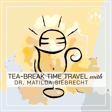
Humans like decorating things - Ep 21
After chatting with Danny all about the tools and techniques used in ancient tattooing, it’s time to talk about the tattoos themselves! For that, Matilda enlisted the help of professional archaeologist Aaron Deter-Wolf, who specialises in the study of ancient tattoos all around the world. But how exactly can you identify tattoos on badly preserved skin? Why were people tattooing in the past? And how can you juggle independent research with a day job? Tune in to this month’s episode to find out!
Also don’t forget that our APN members will be getting a special bonus episode later this week featuring a discussion with both Danny and Aaron about their collaborative projects! If you’re not a member yet, check out the APN membership page here for details.
Transcripts
- For rough transcripts of this episode go to https://www.archpodnet.com/teabreak/21
Links
Contact the Host
- Email: matilda@thearchaeologiststeacup.com
- https://www.thearchaeologiststeacup.com
- insta: @the_archaeologists_teacup
- fb: /TheArchaeologistsTeacup
- twitter: @ArchaeoTeacup
ArchPodNet
- APN Website: https://www.archpodnet.com
- APN on Facebook: https://www.facebook.com/archpodnet
- APN on Twitter: https://www.twitter.com/archpodnet
- APN on Instagram: https://www.instagram.com/archpodnet
- Tee Public Store: https://www.teepublic.com/stores/archaeology-podcast-network?ref_id=5724
Affiliates
- Motion: https://www.archpodnet.com/motion
- Liquid I.V.
Ready to shop better hydration, use my special link https://zen.ai/teabreaktimetravel to save 20% off anything you order.
